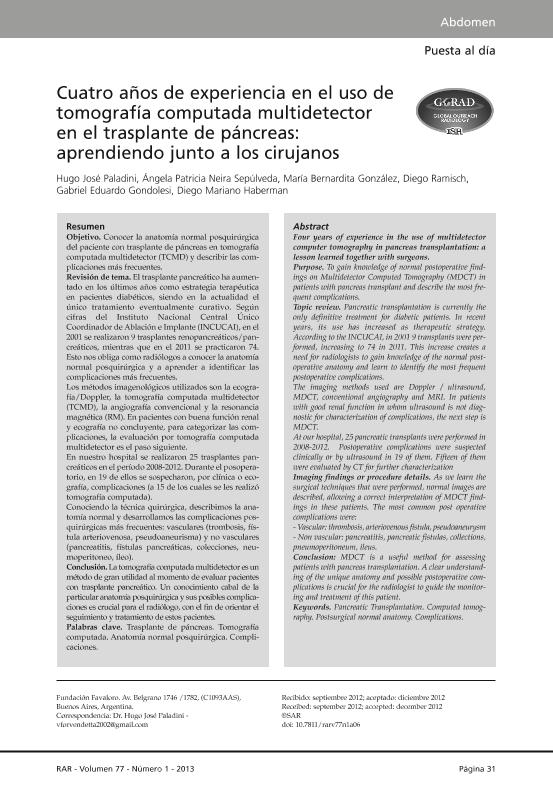Artículo
Objetivo. Conocer la anatomía normal posquirúrgica del paciente con trasplante de páncreas en tomografía computada multidetector (TCMD) y describir las complicaciones más frecuentes. Revisión de tema. El trasplante pancreático ha aumentado en los últimos años como estrategia terapéutica en pacientes diabéticos, siendo en la actualidad el único tratamiento eventualmente curativo. Según cifras del Instituto Nacional Central Único Coordinador de Ablación e Implante (INCUCAI), en el 2001 se realizaron 9 trasplantes renopancreáticos/pancreáticos, mientras que en el 2011 se practicaron 74. Esto nos obliga como radiólogos a conocer la anatomía normal posquirúrgica y a aprender a identificar las complicaciones más frecuentes. Los métodos imagenológicos utilizados son la ecografía/Doppler, la tomografía computada multidetector (TCMD), la angiografía convencional y la resonancia magnética (RM). En pacientes con buena función renal y ecografía no concluyente, para categorizar las complicaciones, la evaluación por tomografía computada multidetector es el paso siguiente. En nuestro hospital se realizaron 25 trasplantes pancreáticos en el período 2008-2012. Durante el posoperatorio, en 19 de ellos se sospecharon, por clínica o ecografía, complicaciones (a 15 de los cuales se les realizó tomografía computada). Conociendo la técnica quirúrgica, describimos la anatomía normal y desarrollamos las complicaciones posquirúrgicas más frecuentes: vasculares (trombosis, fístula arteriovenosa, pseudoaneurisma) y no vasculares (pancreatitis, fístulas pancreáticas, colecciones, neumoperitoneo, íleo). Conclusión. La tomografía computada multidetector es un método de gran utilidad al momento de evaluar pacientes con trasplante pancreático. Un conocimiento cabal de la particular anatomía posquirúrgica y sus posibles complicaciones es crucial para el radiólogo, con el fin de orientar el seguimiento y tratamiento de estos pacientes. Purpose. To gain knowledge of normal postoperative findings on Multidetector Computed Tomography (MDCT) in patients with pancreas transplant and describe the most frequent complications. Topic review. Pancreatic transplantation is currently the only definitive treatment for diabetic patients. In recent years, its use has increased as therapeutic strategy. According to the INCUCAI, in 2001 9 transplants were performed, increasing to 74 in 2011. This increase creates a need for radiologists to gain knowledge of the normal postoperative anatomy and learn to identify the most frequent postoperative complications. The imaging methods used are Doppler / ultrasound, MDCT, conventional angiography and MRI. In patients with good renal function in whom ultrasound is not diagnostic for characterization of complications, the next step is MDCT. At our hospital, 25 pancreatic transplants were performed in 2008-2012. Postoperative complications were suspected clinically or by ultrasound in 19 of them. Fifteen of them were evaluated by CT for further characterization Imaging findings or procedure details. As we learn the surgical techniques that were performed, normal images are described, allowing a correct interpretation of MDCT findings in these patients. The most common post operative complications were: - Vascular: thrombosis, arteriovenous fistula, pseudoaneurysm - Non vascular: pancreatitis, pancreatic fistulas, collections, pneumoperitoneum, ileus. Conclusion: MDCT is a useful method for assessing patients with pancreas transplantation. A clear understanding of the unique anatomy and possible postoperative complications is crucial for the radiologist to guide the monitoring and treatment of this patient.
Cuatro años de experiencia en el uso de tomografía computada multidetector en el trasplante de páncreas: aprendiendo junto a los cirujanos
Título:
Four years of experience in the use of multidetector computer tomography in pancreas transplantation: a lesson learned together with surgeons
Paladín, Hugo José; Neira Sepúlveda, Angela Patricia; González, Maria Bernardina; Ramisch, Diego; Gondolesi, Gabriel Eduardo ; Haberman, Diego Mariano
; Haberman, Diego Mariano
 ; Haberman, Diego Mariano
; Haberman, Diego Mariano
Fecha de publicación:
03/2013
Editorial:
Sociedad Argentina de Radiología
Revista:
Revista argentina de radiología
ISSN:
1852-9992
Idioma:
Español
Tipo de recurso:
Artículo publicado
Clasificación temática:
Resumen
Archivos asociados
Licencia
Identificadores
Colecciones
Articulos(SEDE CENTRAL)
Articulos de SEDE CENTRAL
Articulos de SEDE CENTRAL
Citación
Paladín, Hugo José; Neira Sepúlveda, Angela Patricia; González, Maria Bernardina; Ramisch, Diego; Gondolesi, Gabriel Eduardo; et al.; Cuatro años de experiencia en el uso de tomografía computada multidetector
en el trasplante de páncreas: aprendiendo junto a los cirujanos; Sociedad Argentina de Radiología; Revista argentina de radiología; 77; 1; 3-2013; 31-38
Compartir



